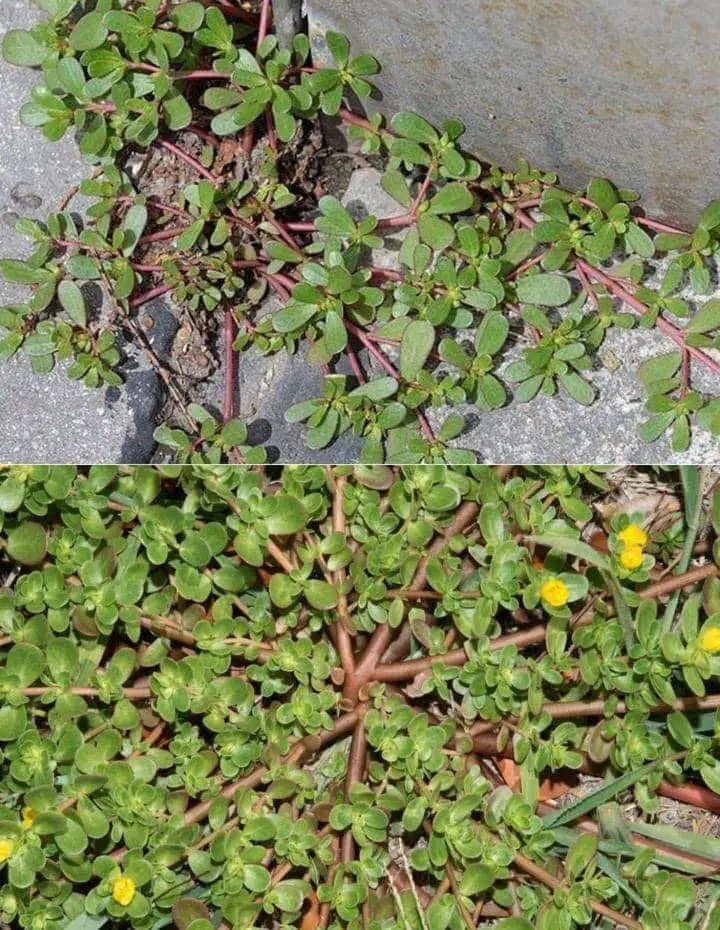Garden plants can be a nuisance, but before you yank them out, consider this: some common plants are actually packed with health benefits and can contribute to your ecosystem. One of these unsung heroes is purslane (Portulaca oleracea), often found in lawns and gardens worldwide. While many see it as an intruder, purslane is a nutrient powerhouse, with unique properties that benefit both people and nature.
What Makes Purslane Special?
Purslane, with its small, succulent-like leaves and yellow flowers, might not look like much at first. However, this plant is rich in essential nutrients that are hard to come by in other plants. Here’s a breakdown of why purslane deserves a spot in your garden:
- Omega-3 Fatty Acids
Purslane is one of the few plants that contain a significant amount of omega-3 fatty acids, particularly alpha-linolenic acid (ALA). These fats are crucial for maintaining heart and brain health. Typically found in fish and flaxseeds, omega-3s are anti-inflammatory and support cardiovascular health, making purslane a valuable addition to a plant-based diet. Just a handful of purslane can help boost your daily intake of this nutrient. - High Nutrient Content
Purslane is packed with vitamins and minerals, including vitamins A, C, and E, as well as magnesium, calcium, potassium, and iron. These nutrients support immune function, bone health, and skin health. Vitamin A, for example, is essential for eye health, while vitamin C acts as an antioxidant, helping to protect cells from damage. - Antioxidants and Anti-Inflammatory Properties
Purslane is also rich in antioxidants like glutathione, beta-carotene, and other phytochemicals. These compounds help protect against cellular damage and have anti-inflammatory properties that may reduce the risk of chronic diseases.
Why It’s Good for Your Yard
Purslane isn’t just good for you; it can also be beneficial for your garden. Here are a few reasons to keep this plant around:
- Prevents Soil Erosion
Purslane spreads across the soil, covering it in a way that helps prevent erosion. This coverage keeps soil from washing away during heavy rains, preserving topsoil quality and structure. - Attracts Pollinators
The bright yellow flowers of purslane attract bees and other pollinators to your garden. By keeping purslane around, you can help support these essential creatures, which, in turn, benefit other plants in your garden. - Acts as a Living Mulch
Purslane’s ability to spread across the ground means it acts as a natural mulch, shading the soil and helping it retain moisture. This can be particularly beneficial in gardens with plants that prefer cooler, moister soil. Keeping purslane as a ground cover can reduce the need for additional mulching materials, lowering maintenance needs.
How to Include Purslane in Your Diet
Purslane has been a staple in many traditional diets worldwide, and its mildly tangy, lemony flavor makes it a versatile addition to various dishes. Here are some ways you can enjoy purslane:
- Salads
Purslane’s crisp texture works wonderfully in salads. Toss it with fresh greens, cucumbers, and tomatoes for a refreshing and nutrient-dense dish. Its slight tartness adds depth to any salad, pairing well with light dressings or vinaigrettes. - Smoothies
You can add purslane to smoothies for an extra nutritional boost. Blending it with fruits like bananas, berries, or pineapple can mask any bitterness while retaining its health benefits. - Soups and Stews
Purslane can be used as a leafy green in soups and stews, much like spinach or kale. It cooks quickly, so add it toward the end of the cooking process to retain its nutrients and texture. - Sautéed as a Side Dish
For a simple side dish, sauté purslane with garlic and olive oil. This quick-cooking method helps bring out its unique flavor while softening its texture.
Purslane in Traditional Medicine
Purslane’s health benefits have been recognized in traditional medicine for centuries. In Chinese medicine, it’s used for its cooling properties, and it’s believed to treat conditions like gastrointestinal distress, skin infections, and inflammation. While more scientific research is needed to validate some of these traditional uses, the plant’s high nutrient profile supports its status as a functional food.
Environmental and Ecological Benefits of Purslane
Aside from its nutritional benefits, purslane plays a role in sustainable gardening and environmental health. Purslane’s adaptability and low water requirements make it an eco-friendly addition to landscapes. By keeping this plant in your yard, you contribute to biodiversity, supporting various insects and reducing the need for herbicides and excessive watering.
- Drought Resistance
Purslane is exceptionally drought-resistant. Its succulent leaves retain water, allowing it to thrive even in dry conditions. In areas where water conservation is essential, purslane can serve as a sustainable ground cover. - Easy to Grow and Maintain
Purslane is a low-maintenance plant. It grows quickly without the need for fertilizers, and its resilience means it doesn’t need special care. If you’re looking for a plant that doesn’t demand constant attention, purslane is an ideal option.
Potential Risks and Precautions
While purslane offers numerous benefits, it’s important to be cautious if you decide to forage it. Some plants that look similar to purslane, such as spurge, can be toxic if consumed. If you’re unsure, it’s best to purchase purslane from a reliable source rather than foraging.
Additionally, those with certain health conditions, like kidney stones, should be mindful when consuming purslane. The plant contains oxalates, which can contribute to kidney stone formation in susceptible individuals. Moderation is key to enjoying purslane safely.
Final Thoughts
Purslane may not look like a hero in your garden, but its impressive nutritional profile and garden-friendly properties make it a plant worth keeping around. Its benefits extend beyond personal health to environmental sustainability and ecosystem support. Next time you see this humble plant, consider giving it a second chance—it might just be the next superfood to add to your meals and your garden.
Embrace this overlooked powerhouse in your yard and see how a simple plant can transform your diet and garden into something even more beneficial!

